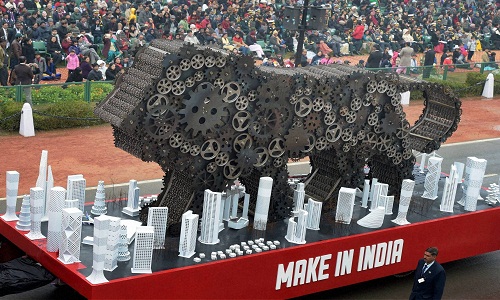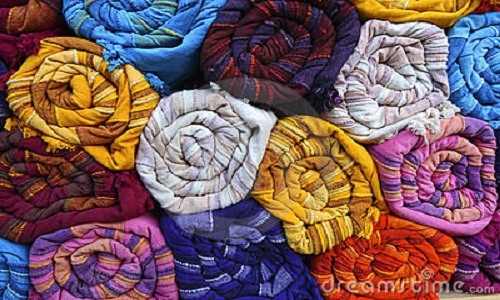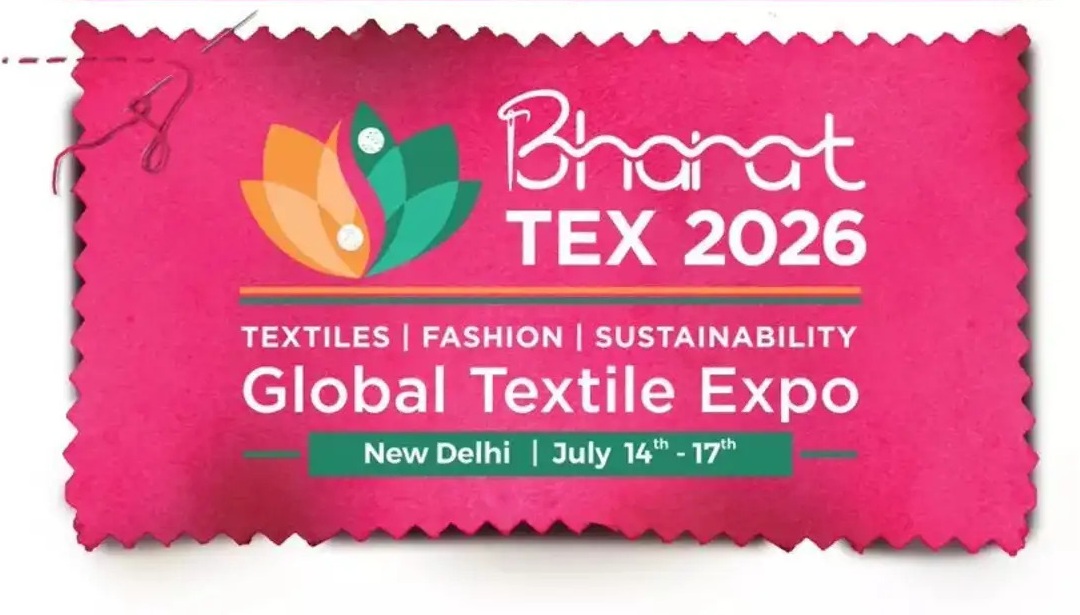FW
Trade show Sourcing at Magic was held in the US, February 15 to 18, 2016. More than 40 countries from around the world set up booths. There was a strong African presence. African manufacturers are trying to take advantage of the African Growth and Opportunity Act (AGOA) a free trade agreement with the United States that allows certain garments from some African countries to be imported duty-free into the US.
Silver Apparel from New Delhi was looking for new geographic territories for its clothing. The company concentrates on brightly colored embroidered tops with a resort feel. Only for You Designs from Mumbai displayed digitally printed tunics and tops. The company’s representative felt the show was slower than in the past but it was the only show on the West Coast where buyers and overseas manufacturers could get together under one roof.
Overall, the busiest section of the trade show was the Made in USA corner. Another popular section was the Wearable Technology hub. There was a lot of interest in that. DuPont highlighted its various wearable technology fabrics. The North Carolina State College of Textiles, which has a course on wearable technology, was there too. Blue Dragon also displayed a 3-D printer.
Overall, the largest representation at the show was by Chinese manufacturers.
www.magiconline.com/sourcing-at-magic
Falling international prices of cotton along with lower imports by China have made India's cotton exports unviable. With falling global prices, farmers who were holding huge stocks, expecting higher demand due to the lower crop, have now started offloading. Result: Prices in the local market have fallen.
India exported 44 lakh bales of cotton so far and the estimate is that 70 lakh bales could be exported this year. At present exports to Pakistan and Bangladesh are happening due to the freight advantage Indian players have. But the fall in Indian prices may not be steep because at lower levels demand from exporters as well as millers will increase and stop the prices from going sharply lower.
At 23.75 lakh bales consumption for November 2015 was down three per cent month-on-month. The cumulative January-November consumption at 277 lakh bales has slowed down to 2.7 per cent from the earlier cumulative growth. Cotton prices in the international market have crashed to a level seen over six years ago.
Prices are the lowest after August 2009. The fall is because of widespread fears that China, which has been a net big importer, will soon start selling cotton from its reserves in markets the world over.
The textile industry in India wants the excise duty on manmade fiber and filament to be halved and changes in labor laws. Also on its agenda is better access to major markets like the US and EU via trade pacts. In India cotton consumption dominates with 65 per cent and manmade fiber and filament at 35 per cent. The industry feels the main reason for low consumption of manmade fibers in India is the higher cost which could be as a result of the excise duty. So a reduction of the excise duty would be a step forward.
The textile sector is confident of providing jobs to unskilled laborers and women as well, even in rural areas, if support is given in the form of higher market access, changes in labor laws and opportunities to scale up. The textile industry is the country’s second largest employer after agriculture. It contributes nearly 14 per cent to industrial production and four per cent to GDP.
The industry’s export earnings grew by 5.4 per cent in 2014-15. The textile industry has two broad segments. First, the unorganised sector consists of handloom, handicrafts and sericulture, which are operated on a small scale and through traditional tools and methods. The second is the organised sector consisting of spinning, apparel and garment segment which apply modern machinery and techniques such as economies of scale.
Most garment companies in Vietnam have orders until the end of the second quarter. Some companies have enough jobs for the entire year. The target to export $30 billion worth of textiles and garments in 2016 appears to be within reach. Orders from importers have come in abundance. The production index of the textile industry grew by 12 per cent in January compared with the same period last year, while the figure was 11.2 per cent in the clothing industry.
The output of fabric made of natural fiber in January reached 30 million square meters, a 10 per cent increase compared with the same period last year, while the output of fabric made of synthetic and artificial fibers rose by 6.5 per cent, to 63.3 million square meters.
In January alone, textile and garment exports brought two billion dollars, up by 5.8 per cent over January 2015. While the number of foreign invested enterprises accounts for 30 per cent of total enterprises in the industry, they make up 70 per cent of the total turnover. Vietnamese enterprises put out the remaining 30 per cent.
Textile and garment companies also look forward to the Trans Pacific Partnership agreement which they feel will bring great opportunities to the industry.
The Woolmark Company and KaDeWe hosted an exclusive event to present the culmination of The Berlin Wool Lab Project, a 12-month collaboration that has inspired and connected some of Germany's top emerging design talent with some of the best Merino wool fabric suppliers in the world. Twelve designers were selected to participate in the project in February 2015 and offered support from The Woolmark Company in obtaining their preferred fabrics from the Spring/Summer 2016 edition of The Wool Lab under the guidance of leading fashion journalist Melissa Drier.
Created twice a year by The Woolmark Company, The Wool Lab is an innovative seasonal guide to the best selection of commercially available wool fabrics and yarns in the world. Outlining the emerging macro-themes from fashion and other fields, it influences emerging fashion trends and both inspires and informs the textile industry, fashion professionals and retailers about the vast potential and trans-seasonal properties of this premium, natural fiber.
The chosen designers in The Berlin Wool Lab Project have been developing Merino wool fabrics into outfits within their Spring/Summer 2016 collections, over the past 12 months, which are now on show in window displays and in-store at KaDeWe until early March and are available to buy form the designers' own websites.
"Since the government has identified India’s textiles and garment category as one of the 25 sectors capable of being a world leader, it has allowed sector (among others) to be the beneficiary of 100 per cent FDI. In the past, key sectors of the Indian economy have been under intense protectionist measures that compel international companies to forge partnerships with local companies if they wished to do business in India."

Affordable raw material, labour, strides in textile technology and the ‘Make in India’ policy could together make India a formidable destination for foreign investment in the textile and garment business. The recent launch of ‘Make in India’ initiative, a part of Modi government’s renewed focus on the country’s economy at a glittering event in Mumbai attracted over 1,000 companies and delegates from over 60 countries. Prime Minister Modi announced sweeping changes in manufacturing sector that employ millions of skilled and unskilled youth.

By opening up to outside investment, partnerships, expertise and efficiencies, the government aims to usher in an era where India will not only produce for the world but also feed a growing consumer base. This applies to the global fashion industry as well.
Textiles, garments sector moves up global ranking
Since the government has identified India’s textiles and garment category as one of the 25 sectors capable of being a world leader, it has allowed sector (among others) to be the beneficiary of 100 per cent FDI. In the past, key sectors of the Indian economy have been under intense protectionist measures that compel international companies to forge partnerships with local companies if they wished to do business in India.
Darshan Mehta, President and Chief Executive, Reliance Brands feels despite India’s natural advantages of robust cotton production, cheap labour and a rich history, the country made way for other ASEAN countries, including Myanmar, Bangladesh and Vietnam to steal a march over India. Says Kulin Lalbhai, Executive Director of Arvind believes, India needs to address the importance of free trade agreements that allows goods from certain countries to come in without duty. However, manufacturing is now being liberalised and the textiles and garment industry should benefit. The changes could not have come sooner given the opportunities being created as China offshore more of its manufacturing, after decades spent competing fiercely with India and other countries.
While recent policy changes are making some headway, manufacturers still face significant hurdles, such as poor infrastructure, corruption, inefficient bureaucracies, access to capital among others feel experts. Nevertheless, with key drivers now established, namely improving the ease of doing business in India and simplifying foreign investment process, the bonhomie is palpable across the business community.
With good reason, business leaders around the world have India in their sights. Recent accolades have been impressive: Ernst & Young and the Financial Times have placed India as a global No.1 investment destination; Frost and Sullivan ranked India No. 1 in the ‘Growth, Innovation and Leadership Index’; Foreign Policy magazine declared India No.1 in the Baseline Profitability Index. And the IMF has ranked India as the world’s fastest growing large economy.
Advantages Indian
India is the world's second largest textile manufacturer, home to 24 per cent of the world's spindles and 8 per cent of the world's rotors. Given the right support, experts say this sector could be one of the biggest success stories to come out of ‘Make in India’, right after the IT sector. According to a report by Corporate Catalyst India published in a July 2015, the Indian textiles industry (currently valued at around $108 billion) is expected to reach $141 billion by 2021 and is the country’s second largest employer after agriculture. Over 35 million people are employed in this sector either directly or otherwise. And the Indian textile industry has the potential to grow five-fold over the next 10 years to touch $500 the billion mark. Of this domestic sales would constitute $315 billion and exports $185 billion.
Already, several major international apparel and manufacturing players have invested in India. These include: textile machinery manufacturers Rieter and Trutzschler, and vertically integrated fashion brands like Zara and Mango (Spain), Promod (France), Benetton (Italy), Esprit, Levi's and Forever 21 (USA). In luxury fashion sector, what is particularly interesting is that the other half of India’s textile story is about handlooms, a subsector which could play a big role in forging the global luxury industry ahead.
International brands such as Chanel, Dries Van Noten, Lanvin, Naeem Khan, Valentino and Elie Saab, are already dipping into this vast reservoir of craft. But the recognition that India’s biggest soft power lies in the country's handwoven heritage is yet to be fully exploited, which means the full benefits to the economy and the workforce remain elusive too.
‘Make in India’ seems heavily skewed towards industrialised textiles, as opposed to handmade textiles. India-based NGO Dasra reports that an estimated seven million crafts people work in the industry, according to official figures (and up to 200 million, unofficial sources). From 2014 to 2015, Indian handicrafts exports stood at $4.5 billion.
EU textile and clothing imports in 2015 picked up by 9.6 per cent in value terms due to sharp increases from Asian countries. Textile sales to the US, EU’s top market, recorded a noticeable growth of 16 per cent thanks to a favorable exchange rate. Moderate expansion was recorded by Hong Kong and China. On the contrary, exports to Russia and Ukraine slipped due to the depressed markets.
Clothing exports to the EU’s main consumers indicated a higher growth rate than for textiles. There was a noticeable growth in clothing exports to the US, Hong Kong, South Korea, Canada and China, which made the US the second largest EU customer and China the sixth largest. Exports to the Saudi Arabian and Mexican markets also experienced a significant expansion. Russia and Ukraine, on the other hand, declined, following the political turmoil.
Textile imports coming from the EU’s top 20 suppliers were all up, except from Egypt, Thailand and Australia. Among the main suppliers, the US witnessed the highest growth, followed by China, Pakistan and Vietnam. At the bottom of the ranking were Morocco and New Zealand.
Clothing imports from most Asian countries recorded double digit growth rates. The top supplier, China, recorded a six per cent increase, with 30 billion of clothing articles sold to the EU market. In the second place, Bangladesh recorded a 24 per cent increase. Strong import upturns were also observed from Cambodia, Vietnam, Hong Kong and the US.
Chinese factory owners, driven by a strengthening currency and rising salaries at home, are relocating to secure more competitive margins. One of these destinations is Rwanda. While most Chinese companies are looking at opportunities close to home in Southeast Asia, more far-flung countries are also beginning to benefit. One of the attractions of African countries is their preferential trade agreements with the US and Europe, which mean that finished products, such as textiles, avoid import duties of up to 30 per cent.
Chinese businessmen believe the advantages of Rwanda’s business-savvy government, the country’s cheap, disciplined labor force and readymade garment factory space outweigh transport and other logistical challenges. And Rwanda, which runs a 17.2 per cent trade deficit, offers hefty tax concessions and other support in an effort to boost foreign currency earnings.
The Chinese, often blamed for destroying African industry by flooding the continent with cheap goods that undercut local markets, are now at the forefront of foreign manufacturers expanding their footprint across the continent. A Chinese garment company will equip Rwandan students with various textile skills. At least 600 students will be trained in embroidery before being taken on for work at the factory.
Action will be taken against factories in Bangladesh which fail to implement adequate fire and building safety measures. A number of readymade garment factories have still not met Accord and Alliance requirements. Accord on Fire and Building Safety in Bangladesh is a grouping of European retailers. Alliance for Bangladesh Workers Safety is a grouping of North American buyers. Accord is a platform of 150 EU retailers while Alliance comprises 26 retailers from North America.
Accord and Alliance conducted inspections in a number of factories and found some had kept fire exits locked during working hours, no clear escape gates, skipped appointment letters to workers and were not regular in salary payments etc. The country has a total of 3,460 clothing factories in operation now.
The industry is rife with horrifically unsafe conditions, corruption, shoddy oversight, low wages, and child labor. The sector’s safety regulations and protections for garment workers remain nowhere near sufficient.
Bangladesh rose to its position largely because of its lack of regulation and the low wages it pays its garment workers, most of whom are women. Bangladesh’s minimum wage for the sector is one of the world’s lowest. As fashion brands look to cut costs, and wages continue to rise in China, Bangladesh becomes an increasingly attractive place to make clothes on the cheap.
Bangladesh Cotton Association (BCA) and Indian Cotton Association (ICA) are jointly organising ‘Bangladesh India Cotton Fest 2016’ in Bangladesh for the first time. The event is highly valued and supported by the most influential trade bodies FBCCI and IBCCI.
Scheduled to be held during March 2016, Bangladesh India Cotton Fest is organized to promote and protect the interest of cotton agents, traders, growers etc. BCA is the national trade body of cotton spinners, cotton agents, cotton traders, cotton growers, cotton ginners and cotton controllers can be labeled as inspection companies, according to a report.
BCA is an affiliated member of the Federation of Bangladesh Chambers of Commerce and Industry (FBCCI) and an affiliated Association of the International Cotton Association (ICA) based in Liverpool, UK. Indian Cotton Association is a Public Company incorporated on 06 April 1965 involved in spinning, weaving and finishing of textiles.
The cotton fest is going to offer a platform where reciprocity is going to be held between buyers and sellers. Hence, the agents are going to get an opportunity to arrange meetings between their buyers and sellers, and help them to finish their business under a festive mode for this current season Indian cotton. It will also play the role of a ‘network’ channel for the buyers, sellers, agents and controllers. Mainly people will do their business with a festive mood.












